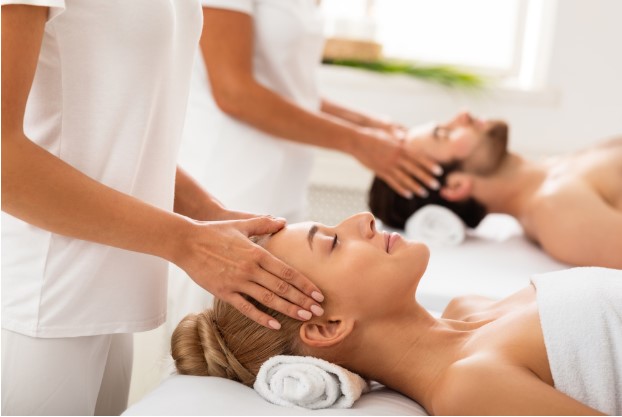Introduction: The Human Need for Shared Healing
In modern life, stress, isolation, and physical strain are common. While many people turn to individual therapies for relief, shared healing practices have gained recognition for their ability to foster connection and collective wellbeing. Among these practices, mutual massage stands out as a powerful way to combine relaxation with emotional bonding. By exchanging care in an intentional and mindful way, participants not only ease tension in the body but also deepen trust, empathy, and resilience.
The Concept of Shared Healing Practices
Healing Beyond the Individual
Shared healing practices are activities where two or more individuals engage in therapeutic methods that support both body and mind. Unlike one-sided treatments, these approaches are reciprocal, offering each participant the chance to both give and receive.
Examples of Shared Healing Modalities
- Mutual massage
- Partner yoga
- Breathing exercises with synchronization
- Meditation circles
- Sound therapy in groups
Each practice emphasizes connection, mutual support, and collective restoration, creating a space where wellness is no longer a solitary pursuit.
Understanding Mutual Massage
What Is Mutual Massage?
Mutual massage involves two individuals alternately giving and receiving massage in a safe, respectful, and mindful setting. Unlike professional massage therapy, its focus is less on technical expertise and more on emotional presence, communication, and relaxation.
Core Principles
- Reciprocity: Both partners benefit equally.
- Communication: Verbal and non-verbal cues guide comfort and technique.
- Intention: Each touch is grounded in care, not performance.
- Presence: Active focus on the moment enhances the experience.
Scientific Foundations of Connection Through Touch
The Physiology of Healing Touch
Touch triggers the release of oxytocin, often called the “bonding hormone.” This chemical response reduces stress, lowers cortisol levels, and fosters feelings of safety and closeness.
Impact on Mental Health
Research highlights how shared physical touch:
- Reduces anxiety and depression
- Enhances mood and emotional stability
- Promotes trust between partners
By practicing mutual massage, participants strengthen both physical health and interpersonal connection, making it a valuable tool for emotional resilience.
The Benefits of Mutual Massage
1. Strengthening Emotional Bonds
Exchanging massage builds trust and communication. This mutual care improves empathy, allowing individuals to connect on a deeper emotional level.
2. Stress Relief and Relaxation
Massage stimulates the parasympathetic nervous system, reducing heart rate and muscle tension. When practiced mutually, stress relief is amplified through shared intention.
3. Promoting Physical Wellbeing
Benefits include:
- Improved circulation
- Reduced muscle stiffness
- Enhanced flexibility
- Better sleep quality
4. Encouraging Mindfulness
Practicing mutual massage requires participants to focus on the present moment—on breath, touch, and response. This enhances mindfulness and reduces mental clutter.
5. Equal Exchange of Care
Unlike professional therapy, where one person gives and the other receives, mutual massage balances roles, ensuring both participants feel nurtured and valued.
How Mutual Massage Builds Connection
Creating Rituals of Care
Making mutual massage a regular practice transforms it into a ritual of connection. Whether shared weekly or monthly, the continuity of care builds security and intimacy.
Enhancing Communication
Participants learn to express needs clearly—whether by requesting more pressure, adjusting position, or sharing feedback. These communication skills extend beyond the massage setting into everyday relationships.
Building Trust and Safety
Safe touch fosters a sense of belonging and reassurance. This trust-building mechanism strengthens personal and relational resilience against stress.
Practical Guide to Practicing Mutual Massage
Preparing the Environment
- Choose a quiet, comfortable space
- Dim lighting and calming music enhance relaxation
- Use natural massage oils for smoother motion
Step-by-Step Approach
- Begin with grounding breathwork together
- Start with gentle strokes on shoulders and back
- Alternate roles after 15–20 minutes
- Maintain open communication throughout
Key Tips
- Respect boundaries
- Adjust intensity based on feedback
- Focus on intention, not technical perfection
Integrating Mutual Massage Into Daily Life
For Couples
A shared massage session can be a meaningful way to reconnect after a long day, fostering intimacy and emotional closeness.
For Friends or Family
Mutual massage can extend beyond romantic partners. Practiced respectfully, it offers comfort, support, and healing in friendships or family settings.
As a Wellness Habit
Incorporating mutual massage into weekly routines makes wellness an accessible and sustainable practice, enhancing long-term wellbeing.
Addressing Misconceptions
It Is Not Only Romantic
While often associated with couples, mutual massage can be practiced in non-romantic contexts as long as respect and consent are prioritized.
It Does Not Require Professional Skill
The goal is presence and care, not technical mastery. Anyone can engage in mutual massage with intention and mindfulness.

Conclusion: The Collective Power of Shared Healing
Shared healing practices provide more than physical relief—they foster resilience, empathy, and connectedness. Mutual massage exemplifies this, offering participants a balanced exchange of care that strengthens both body and mind. By embracing such practices, individuals not only enhance personal wellbeing but also build stronger, more compassionate connections with those around them.


